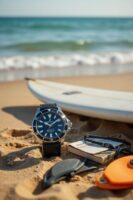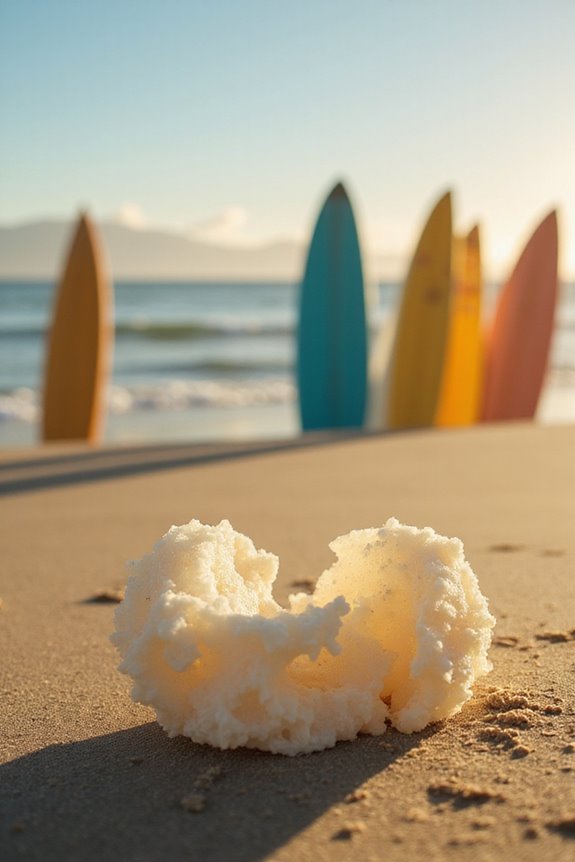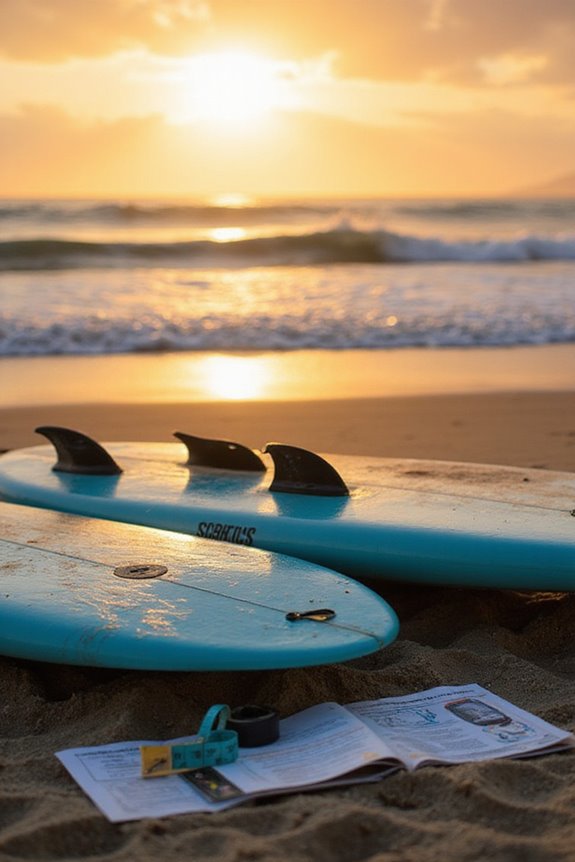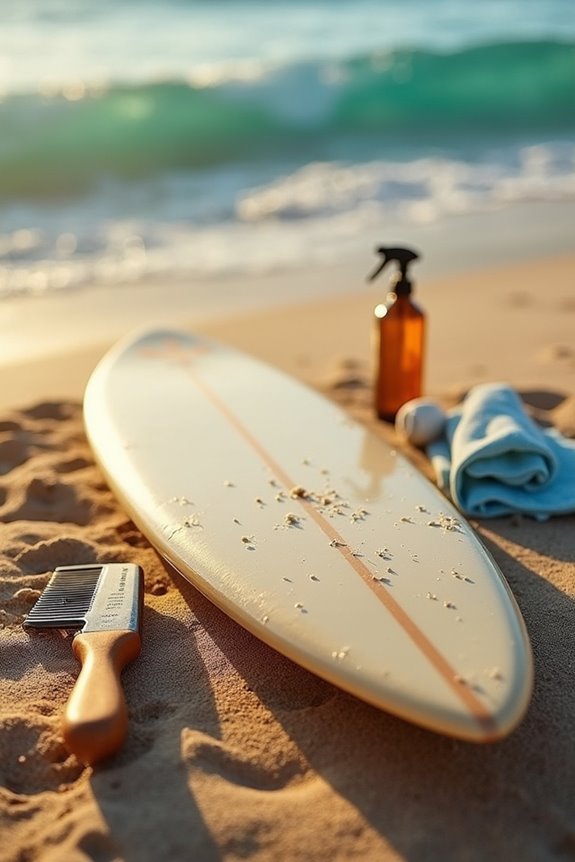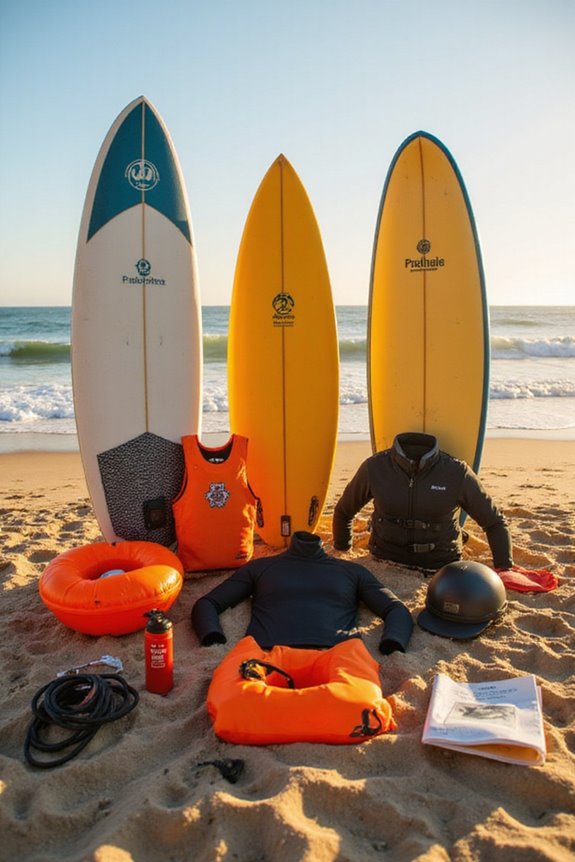To prevent surfer’s ear from cold water, we should use protective gear like earplugs designed for water activities. It’s crucial to monitor water temperatures, avoiding cold waters below 68°F (20°C). After surfing, we must dry our ears properly by tilting our heads and using a soft towel. Wearing wetsuit hoods or swim caps can also help. If we notice symptoms like trapped water or frequent infections, consulting an ENT specialist is essential for ear health. Learn more about preventative measures and aftercare strategies.
Key Takeaways
- Use custom-fit earplugs designed for water activities to prevent water entry while allowing airflow.
- Monitor water temperature; avoid cold water below 68°F (20°C) to reduce risk.
- Wear a suitable winter wetsuit for thermal insulation during cold water exposure.
- Gently dry ears after activities and use a vinegar-alcohol mixture to prevent infections.
- Seek early medical consultation if experiencing trapped water or recurrent ear infections.
Understanding Surfer’s Ear and Its Causes
Surfer’s ear, or exostosis, is a condition we should all be aware of if we spend time in cold water. This abnormal bone growth occurs in the ear canal, forming bony lumps that can narrow and even completely occlude the canal over time. The primary cause of surfer’s ear is repeated exposure to cold water and wind, which irritates the tympanic bone, prompting new bone layer formation. Effective prevention includes using surf earplugs that block water while allowing sound in to protect against irritation. Diagnosis methods typically involve a clinical examination revealing bony growths in the ear canal, along with a patient history of cold water activities. Early signs include water trapping, minor hearing loss, and frequent ear infections, all of which can indicate the progression of this condition.
Importance of Protective Gear
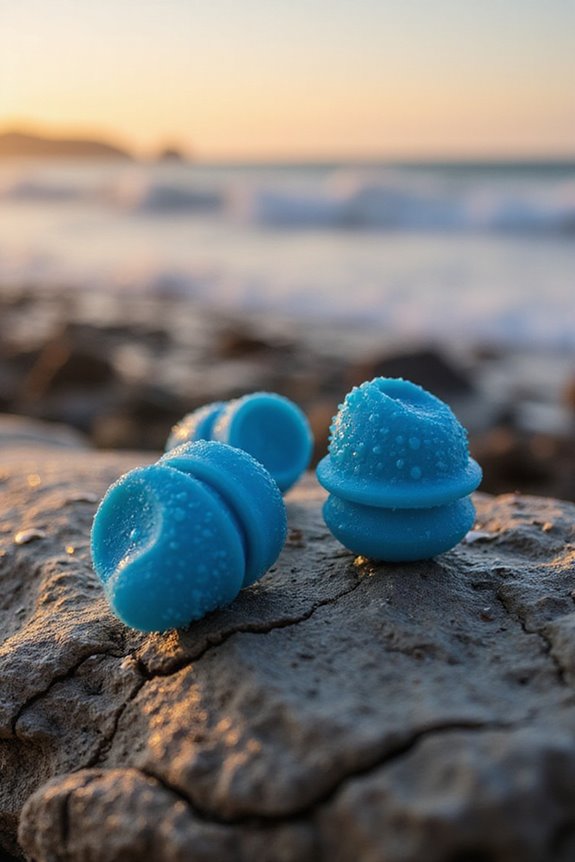
Preventing surfer’s ear involves understanding the importance of protective gear. Using proper protective gear, especially earplugs, is crucial for ear safety. Studies show that earplugs greatly reduce the risk of external auditory exostosis by keeping water out of the ear canal. They allow airflow while blocking water entry, which helps prevent infections without affecting hearing. Neoprene gloves, with their snug fit and thermal protection, can also contribute to overall comfort during cold water activities. Neoprene surf hoods can provide some protection but are not as effective as earplugs. Hoods may trap moisture, increasing risks unless used correctly. To guarantee effectiveness, we should prioritize comfort and fit in our protective gear. Custom-fit earplugs designed for surfing enhance protection and encourage consistent use, helping to prevent long-term ear issues.
Choosing the Right Earplugs

When we’re out in the water, choosing the right earplugs is essential for protecting our ears from surfer’s ear. The materials used in earplugs can greatly affect their effectiveness. Molded silicone earplugs offer a secure fit and can be customized for comfort, while basic foam or wax plugs are less durable.
Fit customization is vital; ill-fitting plugs can let water in and reduce protection. Look for options with multiple sizes or custom molds for a better seal. Some designs include pressure-regulating pinholes to balance hearing and protection. Additionally, earplugs with fixation wings enhance retention during active surfing. By investing in quality earplugs, we can substantially reduce the risk of developing surfer’s ear. Moreover, earplugs with water-repellent filters can effectively block water while allowing ambient sounds, making them a great choice for surfers.
Utilizing Wetsuit Hoods and Swim Caps

Utilizing wetsuit hoods and swim caps can greatly enhance our ear protection while surfing in cold water. Wetsuit benefits include limiting the speed of cold water entering our ear canals, providing insulation, and creating a barrier against wind and water. This considerably reduces our risk of developing surfer’s ear.
Swim cap effectiveness also plays a role; they add a layer of protection against cold exposure, helping retain heat around our ears. Combining both accessories can maximize insulation and minimize cold water exposure, making them especially useful in extreme conditions. For ideal protection, we should guarantee a proper fit and choose materials like neoprene for flexibility and insulation, making our time in cold water safer and more comfortable. Additionally, wearing a wetsuit hood with thermal protection can significantly enhance overall comfort during prolonged exposure to cold water temperatures.
Monitoring Water Temperature
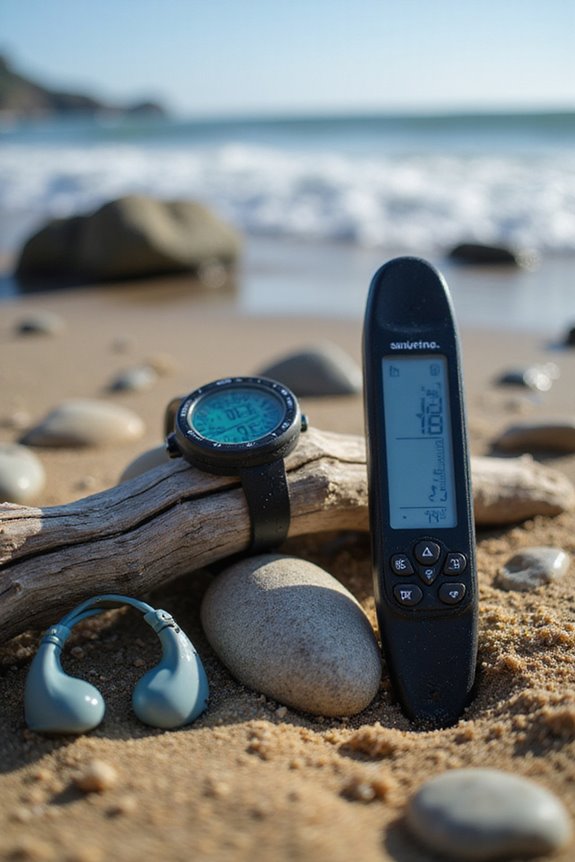
Awareness of water temperature is essential for surfers wishing to safeguard their ear health. Effective temperature monitoring allows us to assess the risks of cold water exposure. Water temperatures below 68°F (20°C) greatly increase our chances of developing surfer’s ear, with temperatures at or below 60°F (15.5°C) raising the risk by 2.6 times. To minimize this risk, we should:
- Regularly check local tide and temperature charts.
- Use thermometers or mobile apps for real-time data.
- Plan surfing sessions when water temperatures exceed the critical 68°F threshold. Additionally, wearing a suitable winter wetsuit can provide thermal insulation and help prevent ear-related issues.
Limiting Exposure Time to Cold Water
Limiting exposure time to cold water is essential for protecting our ear health while surfing. Prolonged exposure can increase the risk of developing surfer’s ear, particularly in water below 64°F (18°C). To manage our exposure limits, we should consider the following strategies:
- Take Breaks: Regularly warm our ears onshore to reduce irritation.
- Set Timers: Use a device to control how long we stay in the water.
- Start Slow: Beginners should limit sessions and gradually increase duration.
- Monitor Conditions: Schedule activities during warmer parts of the day, avoiding water below 68°F (20°C). Additionally, wearing a wetsuit with thermal insulation can help maintain body warmth and protect against cold water exposure.
Drying Ears Properly After Water Activities
Proper ear drying is essential after water activities to prevent discomfort and reduce the risk of infections like swimmer’s ear. Here are some effective techniques to maintain ear health and minimize moisture retention:
- Gently Dry the Outer Ear: Use a soft towel to dry the outer ear without inserting anything into the canal.
- Encourage Drainage: Tilt your head to the side or gently pull your earlobe downward and outward to help trapped water escape.
- Use a Blow Dryer: Set it on low and hold it a foot away to evaporate moisture safely.
- Consider Drying Drops: Apply a vinegar-alcohol mixture post-activity to prevent bacterial growth.
Behavioral Adjustments for Cold Water Surfing
When surfing in cold water, making specific behavioral adjustments can considerably reduce our risk of developing surfer’s ear. Implementing certain behavioral modifications in our surfing habits can be effective.
- Use Ear Protection: We should consistently wear custom-fitted earplugs and consider ear sprays to repel water.
- Wear Neoprene Gear: Neoprene hoods provide insulation and protect against wind chill.
- Limit Water Time: Shorter surf sessions allow for warmth restoration and drying of our ears.
- Monitor Conditions: Avoid surfing during extremely cold or windy days when inflammation risk is higher.
Medical Prevention and Aftercare Strategies
To safeguard our ears from surfer’s ear, integrating medical prevention techniques with effective aftercare strategies is vital. First, we should adopt preventive measures like using custom-fit silicone earplugs, neoprene hoods, and water-repellent ear devices to block cold water and wind. These tools help minimize irritation that leads to bone growth.
Post-surgery care is important if we’ve undergone procedures like canalplasty. We need to keep the ear canal dry for up to six weeks, using prescribed antibiotic ear drops to avoid infection. Additionally, managing discomfort with oral pain relievers and attending regular follow-ups with an ENT specialist guarantees proper healing and monitoring for potential recurrence of exostosis. By combining these strategies, we can effectively protect our ears.
When to Consult an ENT Specialist
Recognizing the right time to consult an ENT specialist is essential for maintaining ear health, especially for those exposed to cold water. We should be aware of indicators such as recurrent ear infections, persistent blockage symptoms like fullness or itching, and unresolved ear pain. A noticeable decrease in ear canal diameter or progressive hearing loss also necessitates an evaluation.
If water gets trapped in our ears after cold water exposure and leads to repeated infections, it’s time to seek help. ENT specialists use diagnostic assessments like otoscopic examinations and audiometric tests to determine the severity of our condition. Early consultation can prevent complications and help maintain our hearing health effectively.
Frequently Asked Questions
Can I Use Regular Earplugs for Surfing?
We wouldn’t recommend using regular earplugs for surfing. They don’t provide adequate ear protection against water and wind. Instead, investing in specialized surfing earplugs guarantees our ears stay safe and comfortable during our sessions.
How Often Should I Replace My Earplugs?
When it comes to earplug maintenance, we should replace earplugs every 1-3 months, especially foam ones, since they wear out faster. Durable silicone materials might last longer, but regular checks are still essential for effectiveness.
Is It Safe to Swim After Ear Surgery?
Is it safe to swim after ear surgery? We must prioritize ear recovery, so let’s follow swimming precautions. Consulting our surgeon and waiting for full healing is essential to prevent complications and guarantee a safe return to water activities.
What Symptoms Indicate a Serious Ear Issue?
Like a storm brewing, persistent ear pain and hearing loss signal serious issues. If we’re experiencing symptoms like recurrent infections or pressure in our ears, it’s time to seek medical evaluation for our health’s sake.
Can Diet Influence My Risk of Surfer’s Ear?
We can’t say diet directly influences our risk of surfer’s ear, but incorporating healthy dietary fats and foods that support immune function might help overall ear health, potentially reducing inflammation associated with environmental exposures.


